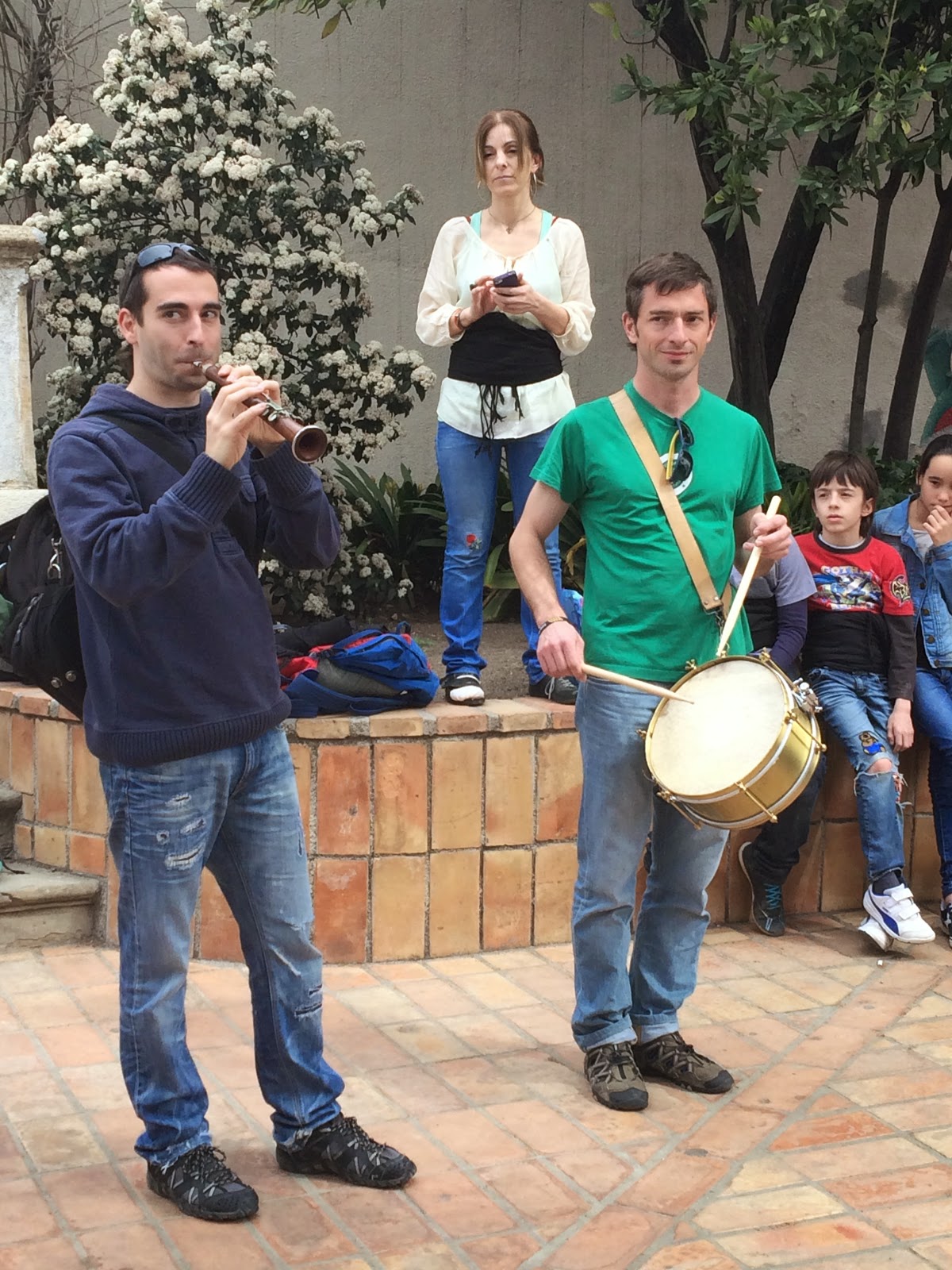See the resemblance?
A common sight at festivals here in Catalunya are human towers or castells erected by castellers, groups of volunteers who train very hard to build amazing structures up to four stories high. One of the best groups in the world are the Castellers of Vilafranca de Penedès, a small town outside of Barcelona.
Here is a photo of their impressive human castles
My hubby is a HUGE fan on castells and so I figured there was no better way to celebrate his birthday than with a surprise castellers workshop with 30 of our closest friends. I told him we would visit and learn the history of the colla (group). What he didn't know was that we would also be building a castell of our own. He was more than a little surprised.
David Miret served as cap de colla or head of the group from 2007-2011.
This person directs the building of the castells from the ground.
We learned that the tradition of building human castles originated near Tarragona in the 1700s but only within the last 50 years has it become popular and spread throughout Catalunya. More info about castellers in general here, and more about the Castellers de Vilafranca de Penedès here.
There are many ways to build a castell: You could have levels composed of 1-5 people, stacked upon each other's shoulders. The highest towers every successfully built are up to nine levels high!
various types of structures
The child at the top is called the enxaneta or rider, and they raise their hand in the air with four fingers up, representing the four stripes on the catalan flag. The person on whom the enxaneta sits is called the aixecador or riser.
When I had viewed castells while standing in an overcrowded plaza during La Mercè, I was always too far away and too short to get a good view. When you are lucky enough to get up close, you can really see the faces of the castellers as they bear ever more weight and risk injury literally climbing on the backs of their teammates with bare feet. You can watch the tower sway slightly, see the grimaces and the trembling limbs as they struggle to maintain their balance. Rarely have we witnessed a tower collapsing, but it is really dramatic. The children who climb to the top wear helmets. One's fall is broken by the heads and shoulders of the pinya below. I often wondered whether I could deal with the smell of so many sweaty people all mashed together. Luckily, it was not a hot day.
A castell in mid-collapse
First, we all put on the long cummerbunds or faixas which support the back and
also serve as a place for climbers to put their feet.
Next we learned how to brace each other in various formations.
Then we worked on standing on the shoulders of others.
Notice the look of terror on his face.
The kids had much less trouble with this.
You really have to trust the people you're working with.
Just standing alone on one person's shoulder was scary. I can't imagine climbing five times higher!!!
Here we are making the pinecone.
The raised hands will hold the legs and butts of the people above to help stabilize them.
The people on the outer layers press inwards and buttress the pinya.
Our final challenge was to build a two by four castell, which means four levels in total including the enxaneta, aixecador, a torre or tower of two people, and the pinya. I was to be part of the torre. I climbed up on my niece's knee and up on my brother-in-law's shoulders, and finally stood a friend's shoulders. I did not even notice the many hands supporting my butt and legs as the two women climbed onto our shoulders. I did notice, however, the pressure on my left shoulder.
We did it!!!
It would have destabilized me to look up and see what the two gals were doing up there, and doubtless for that reason castellers always are accompanied by a drummer and a gralla (like an oboe) player. Specific tunes serve as signals for the ascent, the accomplishment of the castell, and the descent.
The gralla and drum players
There is so much beauty in this activity: Firstly, you take regular people with no particular physical skills, but by trusting each other and having courage, they are able to build something amazing. The contribution of each person is important to the endeavor, from the burliest guy to the tiniest kid. Secondly, it requires focus and dedication. I was all smiles and laughs until the moment when the two women climbed onto my shoulders. Then I put my game face on, and I did what in my flamenco class we call "touching the bottom," tocar fondo, reaching into your reserves and drawing upon the strength you didn't know was there. Building a castell is both an individual and a group challenge, and an adrenaline rush. Often colla members spend years in the group, logging hours upon hours of practice, travel, and competitions. The colla is a social and cultural organization and a symbol of community pride and unity. All of these things make the experience so endearing to us-- a symbol of our three years here in Catalunya: an experience of risk, trust, courage, friendship, hardship, solidarity, accomplishment and belonging.
Our fantastic colla.















